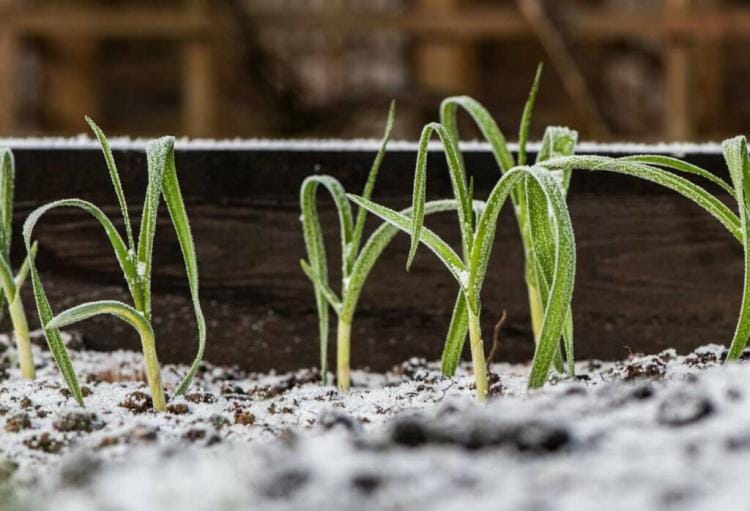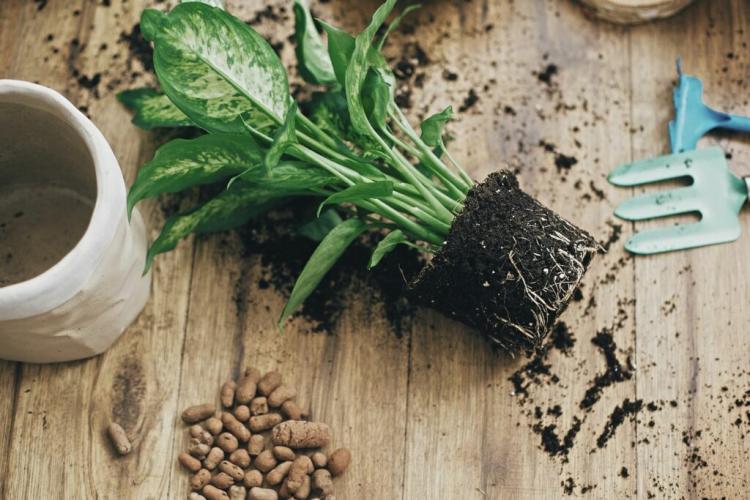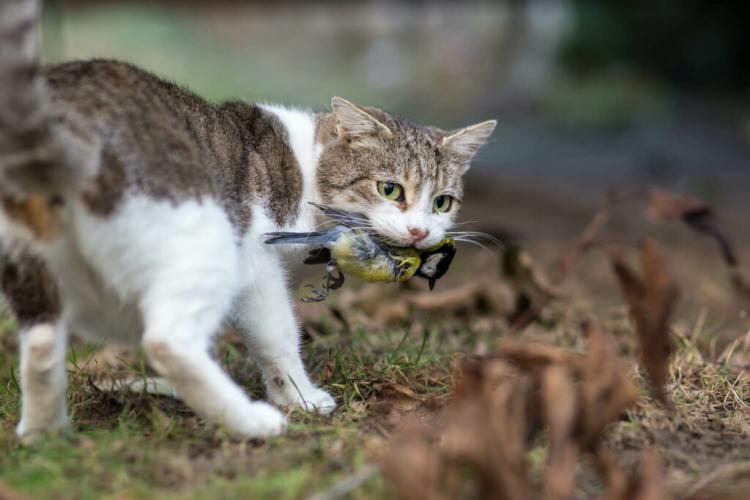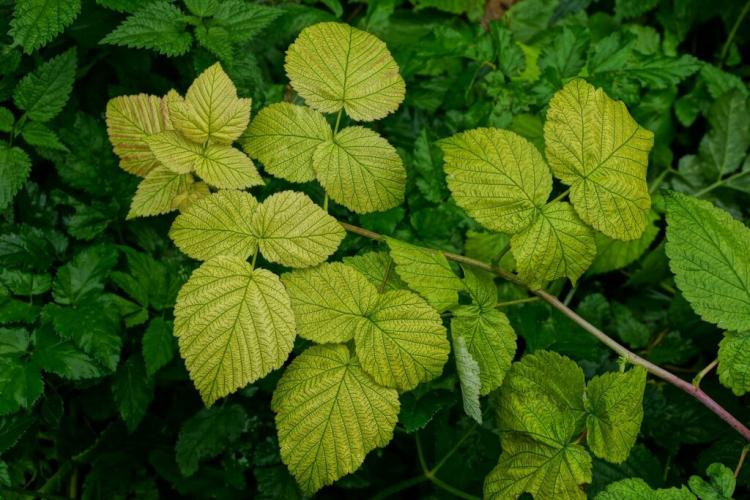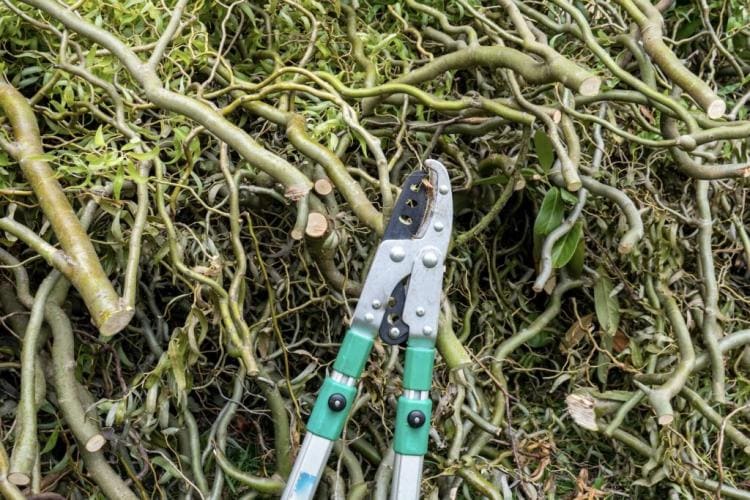Mending & Repairing Lawn: Alternatives to Renewing Lawn
Over the years, the lawn can be visibly affected, especially if the soil preparation and maintenance are not quite optimal. We show practicable methods for renewing the lawn.
Lawn damage can look very different: from large holes to molehills, dog holes to open areas or weed areas. If you want to repair your lawn to solve the individual problem, the right methods and materials should be selected. Otherwise the mending of the lawn may not be effective. Fortunately, holes in the lawn and other damage can often be repaired without a completely new plant. We will introduce you to possible lawn damage and suitable solutions.
Mending or renewing the lawn?
Table of Contents
Creating a new lawn is time-consuming and, with professional help, also costly. The soil must first be prepared for a new sowing and then watered over several weeks. In addition, the area cannot be entered for a long period of time. However, it is not always necessary to completely rebuild the lawn. Much damage can also be repaired through repairs.
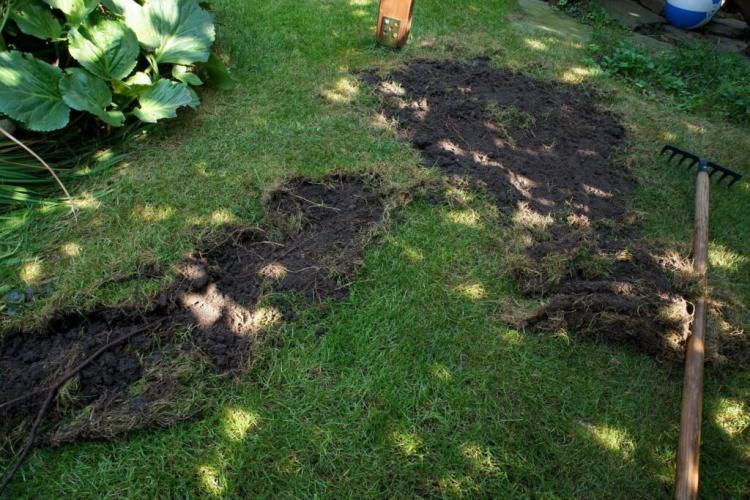
Because new systems are somewhat more complex, repairs are often worthwhile [Photo: aRTI01 / Shutterstock.com]
Tip : It is advisable to repair the lawn in the spring. Early autumn is also suitable. The soil is sufficiently warm at these times and the air is a little cooler so that the seeds do not dry out as quickly.
What should be done with what type of damage?
- Filling small holes in the lawn: They are caused by play activities, trampolines or football goals, digging dogs, weeds, soil compaction or very severe drought. If you want to repair individual and rather small holes in the lawn, it is worthwhile to fill in the gaps with a lawn repair such as our Plantura lawn repair. The lawn repair mix is ideal for leveling holes in the lawn that are up to 50 cm in diameter. You can find out how to do this in the article below. If you have large holes to mend in the lawn, we recommend using a complete lawn seed mixture.
- Repairing burnt lawn: If the lawn loses its green color and becomes yellowish and dry, this can have various causes. Drought and heat induce what is known as heat dormancy in lawn grasses, from which they wake up as soon as the conditions improve. This natural process can be accepted, but it can also be prevented by the annual use of potassium-emphasized autumn lawn fertilizers such as our Plantura organic autumn lawn fertilizer: Potassium ensures drought-tolerant lawn grasses. Properly watering the lawn also helps to prevent “burns”. Stains that look like burned occur when the lawn is over-fertilized – this can be remedied by watering it thoroughly and switching to primarily organic lawn fertilizer.

If the lawn dries out in summer, there is no need to panic [Photo: Yuri Snegur / Shutterstock.com]
- Sowing sparse lawns: If you can see the ground in many places between the grasses, this is a typical case for overseeding. Use high-quality overseeding such as our Plantura lawn overseeding. The reseeding ensures that the lawn becomes dense and carpet-like again. The best way to do this is explained below in the article.
Important: In principle, overseeding lawns is not suitable for mending holes in the lawn, because they are other grass mixtures. A special repair mixture is used for bald spots.
- Mending hollows in the lawn with sand: Depressions and hollows often arise if you have not waited long enough between digging and sowing for the soil to settle on the lawn. The hollows will later interfere with mowing or can even become a trip hazard.
Small depressions up to 3 cm deep can be gradually repaired by spreading a mixture of lawn sand and lawn soil or topsoil in 1 cm layer thickness in spring or autumn. So the lawn can grow through again from below. This process can be repeated 2 – 3 times so that the sink disappears after 1.5 years at the latest.
Deep depressions (> 3 cm), on the other hand, are filled directly with a mixture of lawn sand and turf soil or good topsoil, rolled and then re-sown.
The use of lawn sand such as our Plantura lawn sand makes sense to prevent compaction on the refilled patches – because sand cannot be compressed due to its comparatively coarse grain size, so that the balanced depression cannot simply sink back into place.
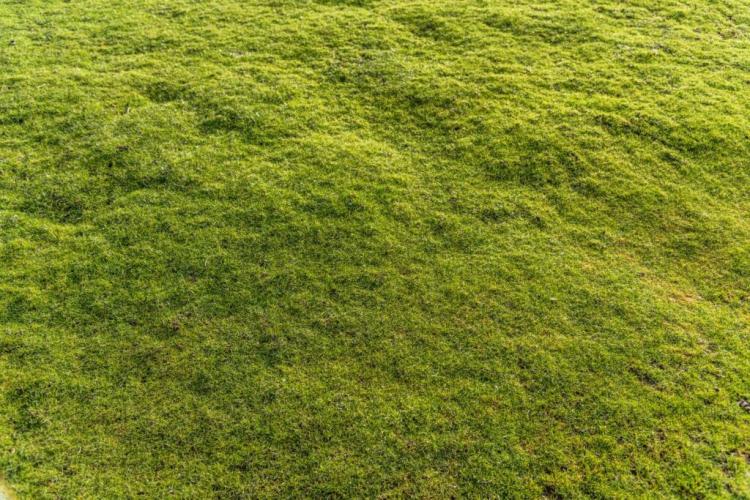
Uneven lawns can be leveled out gradually or all at once [Photo: SJ-3009 / Shutterstock.com]
- If bumps dominate the lawn , for example because the ground in front of the lawn has not been leveled and leveled, the lawn repair is no longer so easy to implement. Then creating a new lawn can make sense.
- Weeds and moss: If your lawn consists predominantly of weeds or moss, mending the lawn is unfortunately often no longer worthwhile. If only small holes are created in the lawn by cutting weeds, these can be filled with a lawn repair. In the case of moss, the first thing to do is to identify the causes of its growth. You can easily find these in our special article on moss in lawns. Only when the causes have been eliminated is it worth scarifying and reseeding or – if there is hardly any lawn left – planting a new one.
Tip: is shade the cause of moss in your lawn? Then it is worth using a shade lawn mixture, the grasses of which are adapted to locations with less light. Our Plantura shadow lawn has fine, glossy green leaves and also grows well in the sun, so it can be used in gardens with different lighting conditions.
- Mole or vole mounds: Voles can be lured with traps in an emergency, but moles are protected species and may therefore only be driven away. There are a number of deterrents against both animals that are quite effective when used regularly. Repairing the damage is only worthwhile when the burrower is no longer up to mischief.

Mounds of earth are not a pretty sight in the garden [Photo: Lumi Studio / Shutterstock.com]
Repairing and touching up lawns: options and guides
In the following, we will introduce you to various ways in which you can successfully repair and repair your damaged lawn.
Mending thinned lawn: The lawn reseeding
A lawn reseeding is carried out when the existing lawn is light because the grasses are missing. It again ensures a denser sward, which on the one hand is nicer to look at and on the other hand does not give weeds any space to germinate and grow. Reseeds only contain Lolium perenne (German ryegrass), because this keeps the lawn dense and regenerative. Unfortunately, Lolium perenne is a little susceptible to frost and therefore always winters out in cold winter locations. Regular reseeding is therefore essential if the lawn is to remain dense. Our Plantura lawn reseeding contains three different, tested varieties of German ryegrass, which guarantees safe emergence and good growth in different locations. In addition, Plantura reseeding is a coated seed that can be distributed particularly evenly and does not dry out as quickly – this ensures trouble-free seed emergence.
Re-sowing the lawn: step-by-step instructions
- Choose the right time: from mid-May to mid-June and September and October are best, as is the case with new lawns. The temperatures should be permanently above 12 ° C and the floor must be above 8 ° C. Also keep in mind that after overseeding the lawn should be protected for about three months.
- Mow the existing lawn to 2 – 3 cm, i.e. quite deep.
- Remove stones, moss, and thatch with a rake. Additional shallow scarifying or raking open the soil so that the seeds can penetrate better.
- At this point, organic lawn fertilization of the lawn area is also a good option to both strengthen the existing lawn and optimally supply the overseeding. For this purpose, a primarily organic lawn fertilizer such as our Plantura organic lawn fertilizer is recommended, the delayed release of which does not hinder the root development of the young grasses.
- We recommend a spreader for optimal distribution of the lawn seeds, but you can also spread the seeds by hand. To do this evenly, first distribute 10 g of seed per square meter in longitudinal strips and then the same amount in cross strips. In the end, a total of 20 g per square meter should have been sown.
- Make sure you water the overseeding every day. This step is essential for a good result, as the seedlings quickly die off when they dry out. After 7-10 days you will see the first germinating grasses. From this point on, you should continue to water daily for about a month. After about three months, the next mostly organic maintenance fertilization is on the plan.
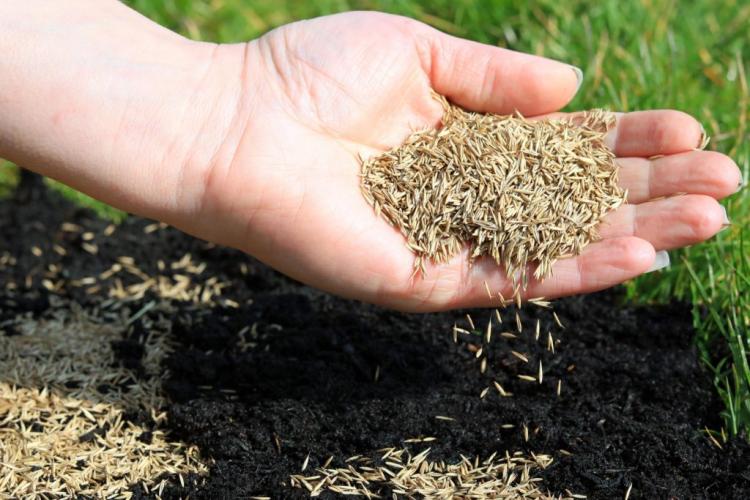
Depending on the use and location of the lawn, the right seeds should be selected [Photo: Dean Clarke / Shutterstock.com]
Tip repairing turf: You can also proceed as described above when repairing turf, provided the lawn has been in place for at least two years. Freshly laid turf may not yet be firmly rooted and should not be worked too roughly.
Mending holes in the lawn : The lawn repair
A high-quality lawn plaster such as our Plantura lawn repair is ideal for repairing individual holes and bald spots in the lawn. It has the perfect combination for mending bald spots in the lawn: an unbeatable mixture of premium lawn seeds of the species Lolium perenne (German ryegrass) and Festuca rubra (red fescue), mixed with a portion of our primarily organic Planutra organic grass fertilizer. In addition, the mixture represents an easily accessible source of phosphate for the young grasses and contains a water-storing germinal substrate. The lawn paving closes holes quickly and competitively so that no weeds emerge and the area is attractive again. The existing lawn then gradually grows again from the edges into the former hole, so that a uniform area soon emerges.
To use it, first loosen the soil slightly at the bare area and remove weeds and stones. Barren soils are improved with a lawn soil like our Plantura organic lawn soil before sowing. Then apply around 150 g of lawn repair per square meter of bald spot – even beyond the edges of the area. Press the seeds lightly so that they are not blown away. Now water the seeds thoroughly and keep them moist for up to a month after germination.
Tip: mend the lawn with turf or pieces of lawn
Sometimes there is no need to buy seeds at all. Small holes in the lawn can be mended with leftover turf. Or you can cut out an excess piece of lawn at the edge of the lawn or at the transition to beds and use it to mend the hole.
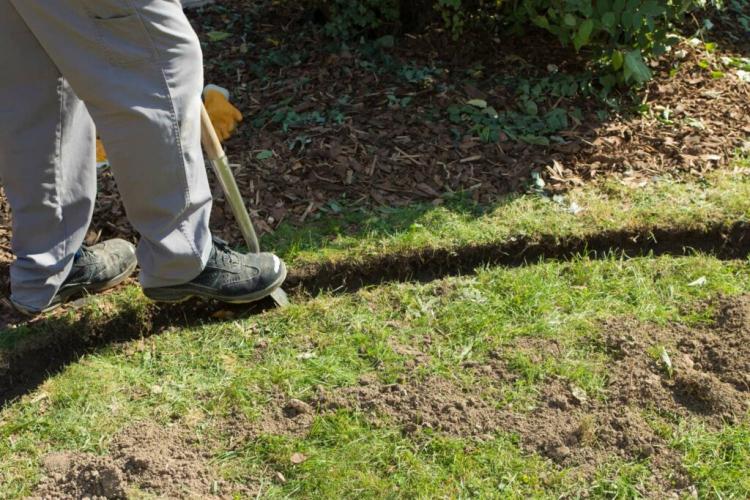
When cutting the edges of the lawn, pieces of lawn often arise that are good for mending [Photo: Artalis / Shutterstock.com]
Spray lawns in the test
The so-called and often advertised spray lawn, which makes overseeding look so easy, unfortunately does not keep what it promises. In various forums you can find experience reports on spray lawns that cast doubt on the value of this invention. In practical tests, some of these products turned out to be poorly functioning, difficult to dose sprays with a high proportion of non-germinable seeds. Often it is not even possible to read from the product descriptions which grass types and varieties are involved, although successful reseeding of the lawn depends crucially on the correct seeds.
Recreate existing lawn: without digging up?
In many cases, the best way to start a new plant is to repair the lawn without digging it up.
However, if the damage to your lawn is so great that it is no longer worth repairing individual areas or re-sowing, there is often no way around a new plant. This is the case, for example, when the soil is too poor or the entire area is dominated by weeds. A lunar landscape full of holes with a lot of bumps is usually remedied with a new lawn. This arises as a result of poor leveling in front of the lawn over the years.
If you have to repair the lawn, it almost always makes sense to remove the old sward before digging it up. Only an open ground can be effectively cleared of weeds, digged up and effectively improved with aggregates such as sand, compost or turf soil. For smaller areas, drive a spade about 1 to 2 cm below the surface of the soil and peel off all of the root felt. For larger areas, a sod cutter is used for this work step. This device works on the same mechanism as the machines that peel off the turf so that it can later be rolled out in a new location.

The removal of the existing sward unfortunately means a great loss of valuable soil for your garden [Photo: ABO PHOTOGRAPHY / Shutterstock.com]
Tip: If weeds are the reason for the new plant, there are other ways in addition to digging to get them under control. However, each method also destroys the lawn. Flaming can be an ecological alternative to spraying the sward with pesticides on areas with strong or deep-rooted weeds. In the case of weeds with taproots, tilling is carried out after flaming and waiting for a few weeks. If new weeds sprout, they are flamed again. Depending on how large your area is, laying out and weighing down black plastic film can kill all living plants.
The removal of the existing sward unfortunately means a great loss of valuable soil for your garden. In order to compensate for the loss of soil, it makes sense to bring in several cubic meters of topsoil on large lawns. High-quality lawn soil such as our peat-reduced Plantura organic lawn soil is used on small areas or in internal gardens with difficult access for trucks.
When choosing lawn seeds, you should use RSM / tested premium seeds in order to create a dense and lush green area over the long term. You can find our high-quality lawn seed mixtures in the Plantura Shop. If you are unsure which lawn mix is right for your garden, this article on choosing your lawn type has all the information you need.
If you have to repair a lawn, it is often based on incorrect maintenance over many years. Lawn care is not that complicated. Our annual lawn care plan tells you everything you need to know about lawn care.

